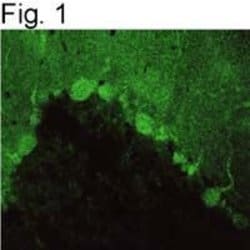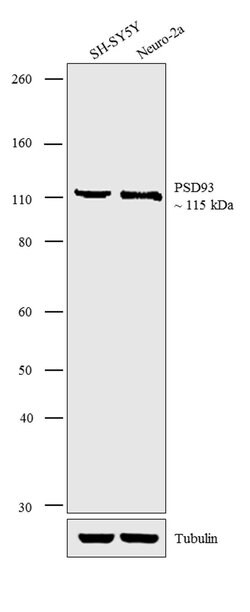Learn More
Invitrogen™ PSD93 Polyclonal Antibody
Rabbit Polyclonal Antibody
Supplier: Invitrogen™ PA1043
Description
PA1-043 detects Post Synaptic Density 93 (PSD-93) from rat and human tissues. This antibody does not detect other synapse-associated protein family members. PA1-043 has been successfully used in Western blot and immunohistochemistry procedures. By Western blot, this antibody detects an ~110 kDa protein representing PSD-93 in rat brain extract. Immunohistochemical staining of PSD-93 in rat cerebellum with PA1-043 yields a pattern consistent with post-synaptic localization. The PA1-043 immunogen is a synthetic peptide corresponding to residues N(352) K L C D K P A S P R H Y S P(366) of human PSD-93. This sequence is completely conserved in human PSD-93. PA1-043 immunizing peptide (Cat. # PEP-021) is available for use in neutralization and control experiments.
PSD-93, also known as chapsyn-110, is one of a family of plasma membrane-associated proteins found in synaptic junctions. PSD-93 is unique among family members in its expression in Purkinje neuron cell bodies and dendrites. PSD-93 has three ~90 amino acid repeats called PDZ domains, a single interior SH3 domain, and a carboxyl-terminal guanylate kinase homology (GuK) domain that is enzymatically inactive. It is hypothesized that PDZ-domain interactions play a role in receptor and channel clustering which contributes to neuronal plasticiyt. PSD-93 is believed to participate in the clustering of certain proteins, including NMDA receptors and shaker-type potassium channels at the synaptic membrane. There are two principal modes of interaction between PSD-93 and other proteins. NMDA receptors and shaker-type potassium channels both share C-terminal sequence homology consisting of a threonine/serine-X-valine-COOH (T/SXV) motif. Other neuronal proteins that share this motif may interact with PSD-93 by binding to its PDZ domains. Neuronal nitric oxide synthase (nNOS), which lacks the T/SXV motif but which has its own PDZ domain, has been shown to associate with PSD-93 in vitro through a pseudo-homotypic PDZ-PDZ interaction.
Specifications
| PSD93 | |
| Polyclonal | |
| Unconjugated | |
| DLG2 | |
| A330103J02Rik; B230218P12Rik; B330007M19Rik; channel-associated protein of synapse-110; channel-associated protein of synapses, 110kDa; Chapsyn-1; chapsyn-110; discs large 2; discs large homolog 2; discs large MAGUK scaffold protein 2; discs, large homolog 2; discs, large homolog 2 (Drosophila); discs, large homolog 2, chapsyn-110; disks large homolog 2; DLG2; Dlgh2; Gm1197; Postsynaptic density protein PSD-93; PPP1R58; protein phosphatase 1, regulatory subunit 58; PSD93; PSD-93; synaptic density protein PSD-93 | |
| Rabbit | |
| Antigen affinity chromatography | |
| RUO | |
| 1740, 23859, 64053 | |
| -20°C, Avoid Freeze/Thaw Cycles | |
| Liquid |
| Immunohistochemistry (Frozen), Western Blot, Immunocytochemistry | |
| 1 mg/mL | |
| PBS with 1mg/mL BSA and 0.05% sodium azide | |
| Q15700, Q63622, Q91XM9 | |
| DLG2 | |
| Synthetic peptide corresponding to residues N(352) K L C D K P A S P R H Y S P(366) of human PSD-93. | |
| 100 μg | |
| Primary | |
| Human, Mouse, Rat | |
| Antibody | |
| IgG |
Your input is important to us. Please complete this form to provide feedback related to the content on this product.


